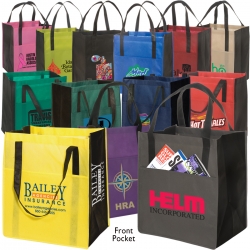Among business functions, Marketing is changing the most; not the goal, but certainly the methods used to build recognition, brand value and, yes, sales. What was regarded as effective five years ago is ineffective today as audiences age and technology offers more interactive options. The rapid change leaves most of us who are “old schooled” in marketing and media buying wondering what to buy in order to develop a high level of recognition. Where do we focus our time in order to build brand value? If engagement is better than traditional mediums that hold audiences at arm’s length, how do we do that well with our limited time and recently reduced budgets? And, while social media does a great job at improving customer relations and humanizing companies, it has yet to show real strength at increasing sales…so, do I go social?
Building Recognition
In walks “promotional products”. In terms of advertising mediums, promotional products has long been thought of as secondary to television, radio, and print advertising, and the add-on to a campaign or media buy. For media buyers who narrowed their focus to “cost per impression” and failed to understand promotional products longevity, or preferred mass mediums, it was considered too expensive. Now, when newspaper readers are declining and magazine ads are proving very expensive for the exposure; with TiVo making it possible to eliminate high-priced commercials, and radio giving way to iPods, media buyers and marketing professionals are taking a new look at promotional products.
According to a 2008 study by the Advertising Specialty Institute, the cost per impression on promotional products averages $0.004 because of their inherent shelf life. This means that they are highly effective in delivering a branded message over and over and over.
Building Brand Value
Brand value is based in how customers respond when they see your brand. It is develop through the culmination of customer experiences. Media is one of several means for experiencing a company brand. Using a product is another one, as is shopping a company’s store location and talking with their sales or service representative. Is it any wonder that marketing places such a high value on control of these interactions?
The challenge is no longer in whether or not we’re saying something of value through our media (most marketing professionals are well versed at building branding statements), but in ensuring that our message is seen/heard enough to develop an acceptable level of recognition.
The 2008 ASI study of business people found that 81% of promotional products are kept because they are considered useful; of these, 56% were kept at home and 28% were kept at the office. The study also found that the average number of impressions for these items is roughly 363 per month. This repeated exposure of the brand on items that are deemed valuable enough to keep is highly effective in adding to brand value.
Engagement
The concept of engagement in marketing is fairly new and is defined as consumer interaction with a company or brand. While many companies wrestle with how to do this through social media, there are challenges with the new media that are inescapable. First, social media is based in scrolling feeds. That means that information is quickly out of sight. Second, marketing professionals are quickly finding out that the nature of people on social media site is to “talk” rather than “listen” (probably because of our human nature to be self-absorbed). So, for companies that wish to listen to consumers talk, it’s great. For presenting a message, it’s risky.
Promotional products are the original engagement tool. By interacting (using) products, consumers develop a higher level of affinity for the company brand. In the 2008 ASI study, 42% of respondents had a more favorable impression of an advertiser after receiving the item, and 24% said they were more likely to do business with the advertiser.
Sales
One of my favorite studies is the 1990 study by the Advertising Research Foundation that found that the strongest factor linking advertising to sales is “likeability” – if respondents liked an ad, they were more likely to buy the product. Since those findings, the ARF has continued to validate the study. The link between these findings and those of the 2008 ASI study are clear – when advertisers place their artwork on a promotional product that is well liked, people are more likely to remember them, have an higher level of affinity for the company, and purchase from them.
The bottom line? In a time when most mass mediums are struggling to get and hold the attention of consumers, promotional products continue to perform well and are a good value for advertisers.
This is a guest post authored by Karen Sherrill, Director of Marketing at Gold Bond, Inc., an ASI Top Forty Supplier in the advertising specialty industry. Follow Gold Bond on Twitter (http://twitter.com/gold_bond) and visit their Facebook page (http://www.facebook.com/pages/Hixson-TN/Gold-Bond/193547465289) for additional information about the company.
